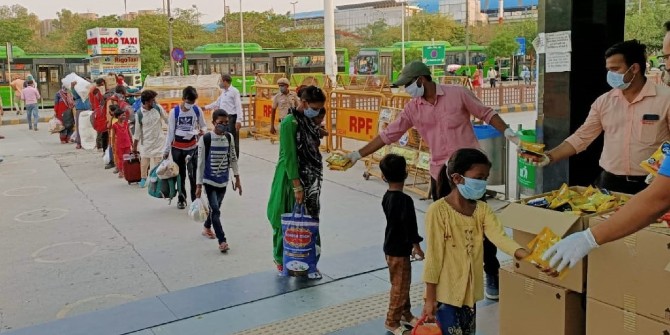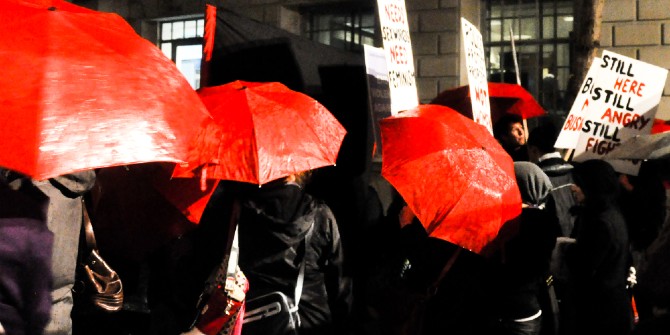COVID-19 has decimated livelihoods in urban India and created a new underclass of workers who are being pushed into poverty. Shania Bhalotia, Swati Dhingra and Fjolla Kondirolli (LSE) say a national work guarantee is needed to prevent mass long-term unemployment and poverty.
Developing economies across the world have large informal sectors, where workers lack even basic social protections like sick pay. India is no exception. Regular wage/salaried employees make up less than half of the urban workforce (48 percent in 2018), and the rest are in a hinterland of casual work, temporary contracts and self-employment. Even among regular employees, only 27 percent have a written employment contract while a little over half have access to some benefits (provident funds, sick pay, health insurance) through the government or their employer. The latter make up the flagship schemes for COVID-19 relief to workers in urban areas which, at the outset, provides limited reach due to large proportions of uncovered workers. Many workers are expected to be covered by these schemes. Yet old and new forms of informality persist, leaving many without basic social protections.

Like many developing economies, India has a young workforce: 62 percent are aged under 40 and most of them are in informal employment. To understand the different impacts of the pandemic, the Centre for Economic Performance (CEP) conducted a survey of more than 8,500 workers in urban India aged 18 to 40 during May-July 2020.
India recorded its first case of coronavirus in late January 2020. Since then, the number of confirmed cases has increased rapidly. The government of India announced a nationwide lockdown aimed at slowing down the spread of COVID-19 on 24 March 2020. The lives of 1.3 billion people came to a standstill for 21 days. Businesses, factories, schools and transport were closed and almost everyone was asked to stay at home. The lockdown was one of the most restrictive in the world, and it was extended three times afterwards until 31 May.
While the initial phase of the lockdown applied everywhere, a more targeted approach was taken later so that some level of normal activity could resume. Most urban centres, especially big cities such as Delhi, Mumbai, Pune, and Kolkata, were classified as red zones during most of the lockdown. This had a large and immediate impact on employment. Millions of workers in urban centers saw their work come to a halt abruptly and many workers who had migrated to these areas were stranded without any source of income.
Labour force participation rates in urban areas were already low (48 percent) and average daily wages were modest to begin with – Rs 590,2 or roughly GBP 6 a day. Our briefing shows that the pandemic has had a dramatic impact on livelihoods in urban areas. 21.7 percent were unemployed or reported zero hours of work during May-July. Many had already not been working since the start of the lockdown and had received zero pay in April (which is the first full month of the lockdown) without any financial assistance. Counting them in, 52 percent of urban workers went without work or pay during the lockdown.
Financial assistance from employers or the government was available to less than a quarter of individuals. In the absence of job protections and government support, worklessness translated into huge reductions in incomes. On average, income fell by 48 per cent after the lockdown in April-May, compared to pre-COVID labour income in January-February.
Covid-19 exacerbated pre-existing inequities in urban India and those at the lower end of incomes suffered the most. Workers in the bottom half of pre-COVID labour income had bigger income losses than the top half. Informal workers, especially young informal workers from lower socioeconomic groups, faced the biggest job cuts. As a result, those in the top quartile of pre-COVID income went on from getting a 64 percent share of total income to a much higher 84 percent within three months. Policy made just a small dent in undoing this steep rise in labour income inequality, taking the share of the top quartile slightly lower to 80 percent or 16 percent higher than before.
Growing urbanisation and an even faster-growing young workforce had already been posing massive challenges for the Indian labour market. The pandemic has intensified the difficulties and these are expected to get even bigger as the urban demography changes over the next couple of decades. Among urban workers, the youngest (aged 18 to 25 years) were already much less likely to be in work, more likely to be employed informally and more likely to be paid less. The pandemic has left the “lockdown generation” with lower employment rates and a legacy of entrenched inequality.
National and state governments recognise the livelihood crisis, but for the most part, their recovery packages fall far short of outlays to overcome it. Although India runs the world’s largest jobs programme (which guarantees 100 days of work to households), it is limited to rural residents. In urban areas, the survey shows that 31 percent of individuals have a guaranteed number of days of work. Among those who do not, an overwhelming 70 percent reported needing a guarantee of a minimum 100 days of work. The youngest workers were much more likely to want a job guarantee, primarily for the livelihood security that they provide in these hard times.
A few states in India are introducing state-level job guarantees for their urban residents, but workers in large parts of the country would fall outside the purview of these state programmes. A national level commitment to overcome the livelihood crisis is therefore essential to prevent urban workers from falling into poverty and for countervailing the sharp and sudden rise in inequality.
This post represents the views of the authors and not those of the COVID-19 blog, nor LSE. This post represents the views of the authors and not those of the COVID-19 blog, nor LSE. It is an edited extract from City of dreams no more: the impact of COVID-19 on urban workers in India, an LSE Centre for Economic Performance briefing.





